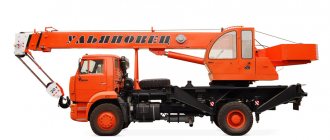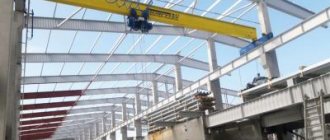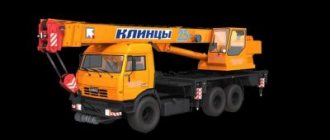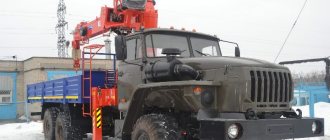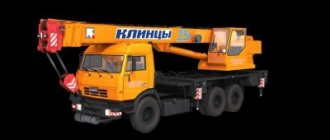What you need to know about a truck crane
Some of the earliest designs of truck cranes date back to the First World War. As countries used heavy equipment to build bunkers and improve military installations, the need for a highly mobile crane was discovered. Many types of rubberized track designs, along with high-speed steel and rubber hybrid track designs, have failed road tests. The installation of a crane mounted on a truck chassis proved very useful - soon most of the countries involved in the war were operating their own versions of the cranes. The modern truck crane can be found in many variations, from truck chassis models to purpose-built wheeled vehicles resembling boom loaders.
A mobile crane is very similar to a crawler crane without tracks. The equipment places the crane boom on a truck chassis with rubber tires. This allows the truck crane to work on public streets and drive itself to the job site without requiring a trailer. The truck crane has outriggers that deploy when the boom is in use, allowing the crane to be kept level and stable. Without outriggers, the crane would be limited in the amount of weight it could lift—it would only be able to carry as much weight as the tires could support.
The function of a crane in a workplace is not easily replaceable. Lifting very heavy objects and getting them into position can be very difficult. A crawler crane can be well suited for this purpose, however it moves very slowly and is limited by its location as it cannot be driven on a public road. The truck crane can install boom work on a tire-powered truck chassis. This allows you to quickly lift equipment to the work site, and then deliver it to another site in a matter of minutes.
The tire is the determining factor in the amount of weight the chassis can support. The truck crane solves this problem by using a hydraulic jack at each corner of the chassis. When the jacks are deployed, the truck crane is actually lifted into the air without the rubber tires making contact with the ground. In this case, the crane is capable of lifting and supporting a large amount of weight.
Affordable and reliable crane remote control systems
Our company, along with the production of cranes, offers the installation of high-quality radio control systems and floor control systems for lifting equipment. You can select and order the optimal type of crane control on the “Radio Control” page of our website.
To order, we will produce a crane of any complexity and modification with the required remote control option already installed on it. We offer delivery and installation of equipment throughout the Russian Federation.
If you have any questions, get more detailed information from our specialists - in any way convenient for you. Our specialists will provide all the necessary information and help you choose a service or product.
Crane Operator Responsibilities
The specialist's area of responsibility depends on the operations he performs. This is due to the fact that there are no universal workers who could operate every type of lifting equipment. Proper operation of any type of crane (tower, bridge, truck, port or beam crane) requires a certain specialization. At the same time, to operate a separate mechanism, you need to undergo appropriate training. The control of a truck crane is carried out by operators, crane operators and lifting equipment operators.
Responsibilities of a truck crane operator
It is also desirable that the crane operator can take part in the repair of the truck crane. In general, this specialist needs to know everything about the design features of this lifting equipment, since he will have to constantly be in contact with it, which means that in the event of a crane malfunction, he must be the first to detect it and promptly take all possible measures to eliminate it.
Crane Operator Responsibilities
The crane operator needs to know everything about the purpose and operating principle of the lift. This specialist must also:
- understand the structure of lifting mechanisms and assemblies,
- use safety devices correctly,
- be familiar with plumbing (locksmith level 4),
- know and follow fire safety rules when operating a truck crane,
- comply with labor protection,
- be familiar with the rules of industrial sanitation,
- be able to operate equipment with a load capacity of 10 to 14 tons,
- have a good understanding of the structure of the power supply conductor of the unit, electrical equipment for starting or stopping the electric motors of the actuators.
What are the responsibilities of a lift operator?
This specialist has the following requirements:
The hoist operator must have excellent reaction time and a number of other professional qualities:
- attentiveness,
- stress resistance,
- prudence,
- discipline,
- composure,
- observation,
- perseverance.
The driver’s work involves the fact that he is always in the cabin at a high altitude, so only people with good health and excellent physical endurance are allowed to perform these duties. Specialists operating a truck crane must have 100% vision, as well as acute hearing.
Ensuring safety during crane operation
During the operation of the truck crane, unauthorized persons must leave the work area.
- It is prohibited to stand under the boom or near the crane, or to use containers moved by the crane to lift people - this can lead to injury.
- It is prohibited to carry out work during thunderstorms, ice, fog, or when wind speeds exceed 15 m/sec.
- It is prohibited to work at a distance of less than 30 m from the retractable part of the crane to the nearest power line without a permit.
- The work plan must indicate safe conditions for installing the crane, in accordance with the configuration of the facility being serviced.
- Load slinging should be carried out in strict accordance with established diagrams.
- In the absence of a full view of the working area from the cab, it is necessary to ensure sign or radio communication between the driver and slingers.
A complete list of safety requirements is available in the Rules for the Design and Safe Operation of Load-Lifting Cranes.
What are the categories of crane operators?
All workers trained to operate a truck crane must have the appropriate qualification level. The presence of one category or another is a determining factor in the distribution of workload, job responsibilities, degree of responsibility and wages. Thus, crane operators with categories from 6 to 8 have a higher salary compared to specialists of categories 4 and 5. Those specialists who have the highest rank are in great demand in the labor market among employers.
There are five main categories for crane operators. It is determined depending on the carrying capacity of the equipment that the employee can operate.
- The 4th category is considered initial - it involves operating a crane with a lifting capacity of no more than 6 tons;
- 5th category - units from 6 to 10 tons;
- 6th category - this includes automobile and crawler cranes, the tonnage of which is 10-20 tons;
- 7th category - equipment with a carrying capacity from 20 to 40 tons;
- 8th category (highest category) - control of forklifts capable of withstanding the heaviest loads - from 40 to 60 tons.
The categories listed above are assigned by Gostekhnadzor. Upon graduation, graduates receive an entry-level certificate. Provided that the student showed stable results throughout the study of the program and passed the exam perfectly, he has a chance to receive a 5th grade. Every year, crane operators, regardless of their level of qualification, are required to confirm their rank, for which a control test of knowledge and rules of working on a truck crane is carried out.
The category can always be upgraded. To do this, a specialist needs to work at a specific enterprise on one unit for a year. During this period, there should not be a single incident of violation of safety rules on the part of the employee. There are also separate retraining courses, after completing which you can obtain a crane operator certificate for operating a heavy overhead or tower crane.
Where to study to become an operator and driver of a truck crane?
You can become a crane operator at a training center that has an approved program. Students with secondary specialized education can take the course. People who do not have medical contraindications are allowed to undergo training as a crane operator:
- diseases of the central nervous system,
- mental disorders,
- epileptic syndromes and other diseases that cause disturbances of consciousness,
- malignant tumors,
- rheumatism,
- chronic kidney and liver diseases,
- chronic skin diseases (eczema and so on),
- glaucoma,
- immobility of the phalangeal joints, absence of phalanges or fingers,
- deafness and chronic unilateral or bilateral purulent inflammation of the middle ear and so on.
Crane operator training can also be provided by specialized centers. It is often practiced for teachers to travel to customer sites. That is, training on how to operate a truck crane takes place directly at the place of work. There are also distance courses, but they are only suitable for obtaining a general idea and studying the theoretical part of the course, and therefore are ineffective.
Obtaining a license to operate lifting equipment
A crane driver's license is the main document that confirms an employee's right to operate a truck crane. The certificate states:
- type of equipment allowed to be driven,
- crane operator qualification.
This document can be obtained after completing a theoretical and practical course, which should be organized in special conditions that reproduce the environment of work sites. After the program is completed, the student will need to pass a certification exam, based on the results of which a decision is made on issuing a certificate and assigning a category.
The duration of training to become a crane operator takes approximately three months, of which one month is allocated for studying the theoretical part, and two for practical training. In general, specialists in this profession can study longer if they have a desire to obtain higher qualifications. To do this, you need to take additional courses.
How long will it take to study
Preparation for operating tower, bridge, portal and railway cranes, including stacker cranes and manipulators:
- theory - 160 hours;
- practice - 240 hours.
Truck crane driver training:
- theory - 160 hours;
- practice - 160 hours.
Advanced training for operators of any type of lifting equipment:
- theory - 96 hours;
- practice - 104 hours.
Recertification takes 24 hours. The preparatory program lasts 40 hours and includes pre-certification training on the “Safety Rules for Hazardous Industrial Facilities that Use Lifting Structures.” The industrial safety course takes 16 hours.
Studying the theory of how to operate a truck crane
Before proceeding directly to operating lifting equipment, students learn the basic rules of operating a truck crane. The theoretical course is conducted in specially equipped classrooms with detailed illustrative materials. These educational aids help to obtain basic understanding of the lifting mechanism necessary at the initial stage of training.
The theoretical course program involves a detailed consideration of the following issues:
- classification and purpose of cranes, their tonnage and internal structure;
- types of slings and lifting mechanisms;
- nuances of performing work on a truck crane;
- rejection methods;
- rules of safe operation;
- ability to work with safety devices.
In addition to how to work on a truck crane, the theoretical course pays attention to teaching communication between future crane operators and other participants in the work process, in particular slingers. Rules for using a two-way radio communication system and filling out a logbook are also studied in theory.
Internship
Practical training is required for those undergoing training in operating lifting equipment. They are carried out immediately after students have learned the rules of working on a truck crane during the theoretical part. For this purpose, training centers have certain basic facilities. Upon completion of the internship, operators are familiar with all the intricacies of operating and controlling a truck-mounted crane. In addition to the fact that in practical classes, students learn how to operate this equipment, they also learn how to promptly detect a breakdown and what measures need to be taken to eliminate it. In addition, the practical course devotes time to studying the rules for operating a truck crane in certain weather and climatic conditions.
